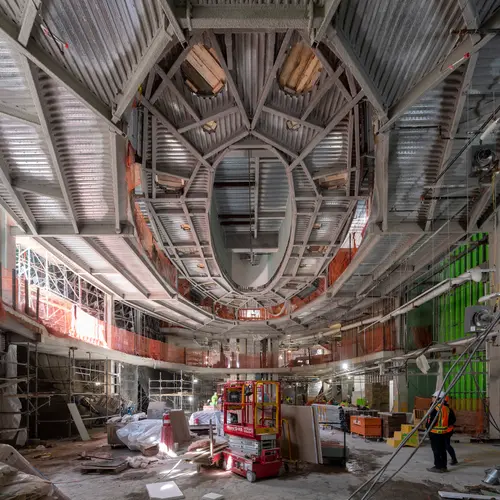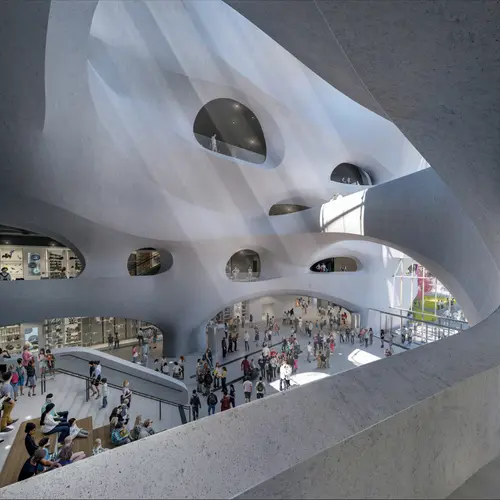Museum of Natural History’s new Studio Gang-designed science center to open next winter

Entrance, © Neoscape, Inc.
After years of delays due to legal action, the American Museum of Natural History’s Richard Gilder Center for Science, Education, and Innovation has an official opening date. The museum on Monday announced the Gilder Center, a 230,000 square foot architectural wonder designed by Jeanne Gang’s Studio Gang, will open to the public next winter. The new center will improve circulation in the museum and help fulfill a 150-year-old vision of creating a continuous campus across four city blocks. It will also provide space for new galleries, educational programs, an expanded library, and a theater.

View of the Gilder Center from Columbus Avenue, ©Timothy Schenck/Courtesy of the American Museum of Natural History
 The Kenneth C. Griffin Exploration Atrium, © Neoscape, Inc.
The Kenneth C. Griffin Exploration Atrium, © Neoscape, Inc.
The new center includes the Kenneth C. Griffin Exploration Atrium, a four-story civic space that will serve as an entrance to the Gilder Center, connecting the museum from Central Park West to Columbus Avenue and opening onto Theodore Roosevelt Park. Billionaire Ken Griffin gave a $40 million donation to the museum, as Bloomberg reported.
The fluid, flowing structure of the atrium was created using a construction technique known as “shotcrete,” invented by AMNH naturalist and taxidermy artist Carl Akeley. Structural concrete is sprayed directly without formwork and finished by hand to create a fluid look.
According to the architects, the Gilder Center creates roughly 30 connections among 10 buildings, including the recently opened Allison and Roberto Mignone Halls of Gems and Minerals.
“Our design works with the Museum’s mission to make their collections visible, legible, and accessible from both inside and out,” Gang said. “It creates an exciting new entrance and new connections among existing buildings that will transform visitor flow through the entire campus. Experientially, the architecture intends to kindle the spirit of discovery and offer an invitation to explore.”
 The Gottesman Research Library and Learning Center in the daytime, © Neoscape, Inc.
The Gottesman Research Library and Learning Center in the daytime, © Neoscape, Inc.
 The Davis Family Butterfly Vivarium, © Neoscape, Inc.
The Davis Family Butterfly Vivarium, © Neoscape, Inc.
The Gottesman Research Library and Learning Center will allow visitors to better connect with the museum’s world-class print and digital resources. The three-story Louis V. Gerstner, Jr. Collections Core will give visitors a glimpse into the process of scientific discovery through the museum’s collections of scientific specimens like fossils.
The 5,000-square-foot Susan and Peter J. Solomon Family Insectarium will be the museum’s first gallery in over 50 years dedicated entirely to insects. Guests will also be able to interact with free-flying butterflies in the new Davis Family Butterfly Vivarium, a year-round exhibition.
 Construction of the Invisible Worlds Theater, © Timothy Schenck/Courtesy of the American Museum of Natural History
Construction of the Invisible Worlds Theater, © Timothy Schenck/Courtesy of the American Museum of Natural History
Guests will be immersed into the networks of life on all scales in the new Invisible Worlds Theater, a 360-degree theater providing visitors with a breathtaking experience that combines science and art.
“As New York City, our country, and the world continue to recover from the pandemic with science leading the way, there has never been a more urgent time to share our Museum’s mission of scientific research and education,” Ellen V. Futter, president of AMNH, said in a statement.
“The Gilder Center uses modern architecture and design, coupled with the most advanced and inventive exhibition and science visualization techniques, to reveal the evidence and processes of science—and, through these, its vital importance and integrity as a force in our society.”
 Skylights, ©Timothy Schenck/Courtesy of the American Museum of Natural History
Skylights, ©Timothy Schenck/Courtesy of the American Museum of Natural History
The project will also implement a number of improvements to the adjacent section of Theodore Roosevelt Park, including a new park entrance, more open space, better seating and space for movement, and new plantings.
Construction began in June 2019 after years of delays due to a lawsuit concerned with the new center’s proximity to Theodore Roosevelt Park. Filed by a group known as the Community United to Protect Theodore Roosevelt Park, the lawsuit claimed the construction would destroy public parkland and damage the surrounding environment. The legal action was ultimately dismissed in court.
RELATED:
- Seven years in the works, Jeanne Gang’s $383M Museum of Natural History expansion breaks ground
- Judge rules in favor of Studio Gang’s Natural History Museum expansion plans despite lawsuit attempt
- Museum of Natural History expansion plans stalled by restraining order and lawsuit
Renderings courtesy of Neoscope, Inc; Construction photos ©Timothy Schenck/Courtesy of the American Museum of Natural History











































